The Elements Of A Tennis Forehand
The forehand is a shot in tennis hit with your dominate hand on the dominant side of the body. To learn how to hit a forehand in tennis you must learn the elements of the forehand. The elements that make up the forehand is footwork, ready position, court position, the swing, and recovery after the shot. The swing is the most talked about and worked on, but a winning player will keep the other 4 elements front of mind as well.
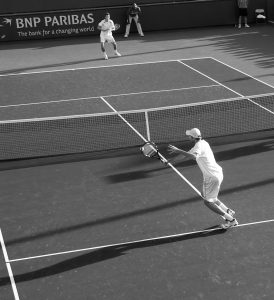
Footwork of a Forehand
Footwork is essential for any shot in tennis starts. It is a part of each and everything we do in tennis. Your feet will put you in the right spot, keep you balanced while you hit the shot, and place you in the right spot after the shot.
When preparing for a forehand (or any shot), you want to be in the ready position. We are discussing footwork first because you need it to get yourself into the ready position using footwork. You also need to use footwork while you are in the ready position.
To get into the ready position, get on the balls of your feet and begin to bounce up and down without ever leaving the ground more than an inch or so and without touching your heel to the ground. While keeping your feet pointed toward the other side of the net, shuffle laterally toward the center of the court.
Begin by stepping with the foot closest to the court’s center and pushing off with the opposite foot. Avoid crossing your feet, as you will lose court coverage and positioning. It is the first step in learning how to hit an effective and consistent forehand tennis shot.
When you arrive at your position the ball will be on your forehand side. As you arrive at the ball you will plant with your dominant foot, and step forward with your opposite foot as you hit the ball. As you hit the ball and step into it, bring your back foot forward and finish with your feet squared up to the net. You should be on the balls of your toes, shuffling slightly toward the middle of the court in order to gain more court coverage. This is when you head for the ready position.

Ready Position
To hit a tennis forehand you must get yourself to that ready position. When near the center of the court and in the most optimal position, continue bouncing slightly using your toes. This will allow you to be ready to explode from your position to where you need to be after the opponent hits their shot. Have your racket out in front of you prepared as if you are going to hit a volley. The face should be about neck or head high, without being uncomfortable or impeding your vision.
The dominant hand should be holding the grip with their preferred forehand grip. It may be more comfortable to use a continental grip here and switch to a forehand or backhand grip when necessary, but, I prefer waiting with a forehand. This allows me to know I’m ready for that shot and only have to adjust for the backhand. Because my non-dominant hand will be on the grip for a backhand anyway, it’s easy for me to use it to help change my grip to a backhand.
The non-dominant hand will be higher up on the racket, on the throat or high part of the grip. It is there for support and is ready to guide or assist the dominant hand.
Your shoulders should be square to the net, with your eyes on the other player. Watch his movement and swing, and you will likely get an idea where he is going to hit the ball. Be careful not to make an impulse decision on where the ball is going, as guessing wrong will lead to an easy winner for your opponent. Once you know where the ball is going, then you can head that direction.
Court Position For a Forehand
The court position to be in to hit a forehand is where your body will be about an arms length away from the ball while the ball is flying toward your dominant side.
To reach optimal court position, use the same movements as described earlier, shuffling laterally and not crossing your feet. Circumstances change throughout a match and there are times to break this rule. When needing to do a full out sprint, you may have to cross your feet. When needing to shuffle faster, your feet won’t stay pointed toward the net the whole time. Adjust for these situations as you go, remembering the basic elements.
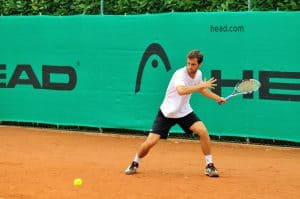
Open Stance
An open stance is more of a modern stance. The advantage of an open stance is it allows you to use more angles of the court in your shots. The disadvantage of it is comfort and perhaps a perceived lack of power. I say perhaps because using an open stance minimizes stepping into the ball which is a technique use in a closed stance to add power to your shot. However, an open stance allows you to rotate your hips which can also add power.
As you arrive at your spot, turn your body so your non-dominant shoulder is angled slightly toward the net. Your dominant foot will be behind you and roughly parallel to the net. Your left foot will be angled toward the net, almost pointed directly at the net, and just to the non-dominant side of you.
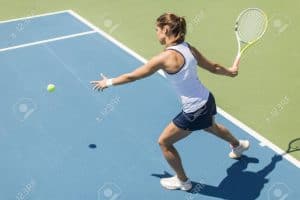
Closed Stance
A closed stance is more traditional and allows you to step into the ball. This will create more power and is very effective for moving to the net.
As you arrive at your spot, turn your body so your shoulders are almost completely perpendicular to the net. Your dominant foot will parallel to the net and behind you. Your non-dominant foot will be almost parallel to the net, but actually angled slightly toward the net.
The Tennis Forehand Swing
The swing is the most dissected and the most important element to learning how to hit a proper tennis forehand. It can be broken down into 4 parts: the grip, the backswing, the point of contact, and the follow through.
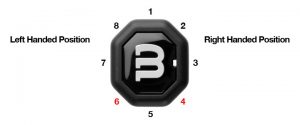
The Forehand Grip
There are 4 major choices to the forehand grip: Continental, Eastern, Western, and Semi-Western.
Continental Forehand Grip
To hold a tennis racket with a continental grip place the heel of your hand on the octagonal plane the is in line with the side of the racket head that will be pointed toward the sky during the shot. Have the base knuckle of the index finger on the 1st octagonal plane to the right (for right handers). This will give you a consistent shot. It is the first grip taught and the easiest to begin with.
Eastern Forehand Grip
To hold a tennis racket with an eastern grip place both the heel and the base knuckle of the index finger on the octagonal plane in line with the side of your racket that is pointed skyward. This will usually result in a flatter shot, which is a shot with little to no spin.
Western Forehand Grip
To hold a tennis racket with a western grip place the heel of your hand on the octagonal plane that is 3 planes to the right (if your right handed) of the plane used on the 2 previous grips. Your index finger base knuckle should be placed on the 1st plane to the right. This will result in an extreme topspin shot.
Semi-Western Forehand Grip
To hold a tennis racket with a semi-western grip, rotate the racket to the right (again, for right handers) 1/8th turn so that your heel and base knuckle are one plane to the left of your western grip hand placement. This is among the most popular forehand grip choices. I use this grip to get great topspin on the ball without too much worry of putting the ball at the bottom of the net. It also allows me to switch easily to a different grip if necessary.

Forehand Backswing
The the backswing is where you will load for your forehand shot. As you turn your body, bring the racket back slightly and allow your racket to loop slightly toward the ground. As you begin, your forearm should be mostly perpendicular to the ground, with your elbow just slightly lower than your wrist. As you loop your shot down, your wrist position will change more than your elbow position to allow your racket head to reach the roughly the height level you will hit the ball on. For a low ball you can have the racket lower than the ball. For a high ball you can have the racket higher than the ball. Now you are ready to let it fly!
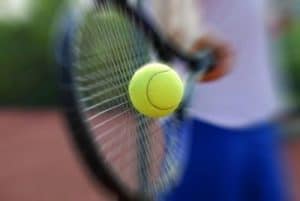
Forehand Point of Contact
The point the racket hits the ball is the point of contact in a tennis swing. It should be a few inches closer to the net than your body. If you hit the ball at your body or behind it, this will limit all of your angles except the most difficult. Your power will be diminished severely as well. Hitting the ball in front, whether with an open or closed stance, will keep these options open. Note that another benefit to an open stance is it allows for late shots to have more angle options.

Follow Through of a Forehand Shot
The follow through should be a continued version of the stroke you have already started. If your racket head started lower than the ball and is heading upward to hit the ball, then it should continue heading upward on the follow through. If it was on the same plane as the ball, then it should finish on the same plane. If it started high and then went low, then finish low.
Taper off the severity of the angle after you hit the ball, or you will see the ball travel in an exaggerated fashion in the direction of your follow through. The rackethead should finish behind the non-dominant side of your body (the backhand side).
If you shorten the follow through you are likely to take some power off of your shot. Consequently, if you lengthen your follow through you are likely to add a bit of power to your shot.
Tennis Shot Recovery
The recovery of your forehand shot will prepare you for the next shot. As soon as your shot is hit, use the footwork techniques to move into your next position. Use strategy to decide where that position should be. Get there as fast as you can and get back into the ready position. Now you are ready to hit the next shot, forehand, backhand, or otherwise.
Good luck out there, and enjoy using these principals on how to hit a tennis forehand shot!

